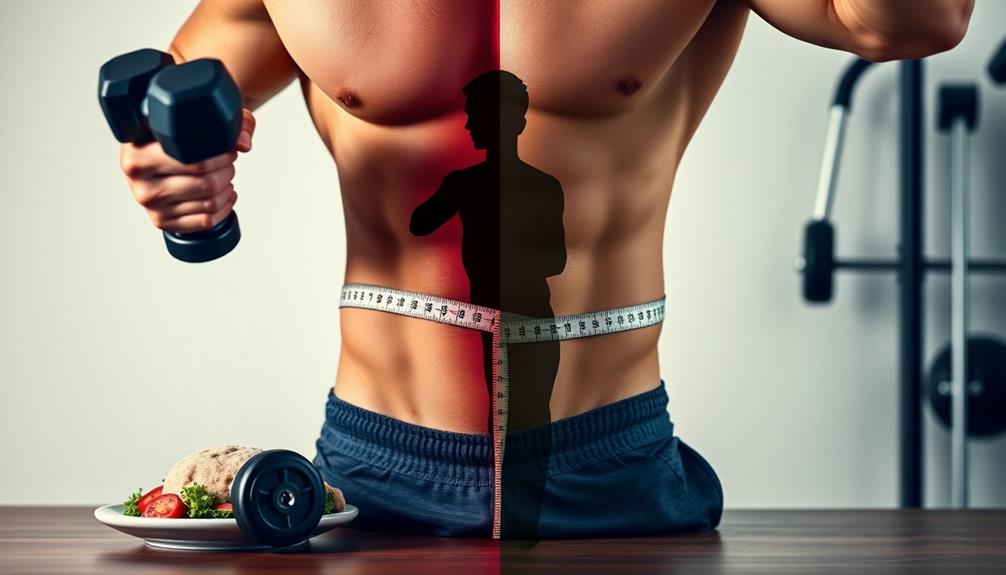To cut fat without losing muscle gains, focus on these key strategies: Maintain a high protein intake of 1.6-2.2g per kg of body weight daily. Create a moderate calorie deficit of 300-500 calories below maintenance. Stick to your resistance training routine, aiming for 3-4 sessions weekly. Prioritize 7-9 hours of quality sleep nightly for recovery. Consider intermittent fasting, like the 16/8 method, to reduce overall calorie intake. Optimize meal timing by eating protein within 30 minutes of waking and after workouts. Implement refeed days to boost metabolism and preserve muscle mass. These tips will help you achieve your goals while maintaining your hard-earned muscle.
Core Insight
- Maintain high protein intake of 1.6-2.2g per kg body weight daily, spread across meals and snacks.
- Create a moderate calorie deficit of 300-500 calories below maintenance, losing fat slowly.
- Continue or increase resistance training, focusing on compound exercises 3-4 times weekly.
- Prioritize 7-9 hours of quality sleep nightly to support muscle repair and regulate hormones.
- Consider intermittent fasting methods like 16/8 to reduce overall calorie intake while preserving muscle.
Maintain High Protein Intake

Keeping your protein intake high is key when cutting fat and keeping muscle. Aim for 1.6 to 2.2 grams of protein per kilogram of body weight each day. This higher protein intake helps keep muscle during a calorie deficit. Protein powders can be great supplements to help you hit your daily protein goals, especially when cutting calories.
Eat high-quality protein sources throughout the day. Include lean meats, fish, eggs, dairy, and plant-based options like legumes and tofu in your meals. Spread your protein intake across multiple meals and snacks.
If you're having trouble meeting your daily needs through whole foods, think about using protein supplements. Whey, casein, or plant-based protein powders can be handy options. While protein is important, it's not the only thing that helps keep muscle. Pair your high-protein diet with regular strength training to keep as much muscle as possible during your fat-cutting phase.
Create a Moderate Calorie Deficit

To lose fat, you need to eat fewer calories than you burn. But don't cut calories too much, or you could lose muscle. Try eating 300-500 calories less than you normally would each day. This should help you lose about 0.5-1 pound per week.
After workouts, eat some carbs to help your muscles recover. Carbs will give you energy and help rebuild your muscles.
Here's how to get started:
- Figure out how many calories you need to maintain your current weight.
- Eat 10-20% less than that number.
This will help you lose fat slowly and keep your muscle. It's a healthy way to slim down and get in shape.
Incorporate Resistance Training

Cutting calories is key for losing fat, but resistance training is just as important to keep your muscles. Stick with your current strength training routine or even step it up a notch. Focus on exercises that work multiple muscles at once, like squats, deadlifts, bench presses, and rows. Aim for 3-4 resistance training workouts each week, making sure to hit all the major muscle groups. Resistance bands are a great option for home workouts or when you're on the go. They come in different resistance levels, so you can keep challenging your muscles as you get stronger.
When you work out, focus on heavy lifting with lower reps (6-8) to help keep your muscles. Don't forget to gradually increase the weight as you get better. This tells your body to hold onto muscle, even when you're eating fewer calories. Make sure to rest enough between workouts, since recovery is crucial for keeping your muscles. By combining resistance training with your calorie deficit, you'll have a better chance of losing fat while keeping the muscle you've worked so hard for.
Prioritize Sleep and Recovery

Sleep is a crucial aspect of preserving muscle while losing fat. When you're trying to shed body fat and maintain muscle mass, getting enough rest becomes even more important. Aim to get 7-9 hours of quality sleep each night to help your body recover. Consider using sleep aids to improve the quality of your rest. These products can help you sleep more deeply and wake up feeling refreshed.
Getting enough sleep and prioritizing recovery has several benefits:
- It helps regulate hormones, especially growth hormone and cortisol
- It supports muscle repair and growth
- It improves appetite control and reduces cravings
Utilize Intermittent Fasting

Intermittent fasting is a popular way to lose fat and keep muscle. It involves cycling between periods of eating and not eating. One common method is 16/8, where you fast for 16 hours and eat within an 8-hour window. During your eating window, focus on eating nutritious foods with enough protein to maintain muscle. To recover well after workouts, consider having fast-digesting carbs to quickly refill your energy stores.
When starting intermittent fasting, ease into it and pay attention to how you feel. You might feel hungry at first, but this usually goes away as your body gets used to it. Drink plenty of water during fasting periods and break your fast with a balanced meal. Intermittent fasting isn't about extreme calorie cutting; it's about timing your meals wisely. This approach can help you eat fewer calories overall while possibly boosting your metabolism and preserving muscle.
Optimize Meal Timing

Timing your meals strategically can help you lose fat and maintain muscle more effectively. When using apps or websites to track meals and nutrition, be mindful of privacy considerations. Optimizing when you eat maximizes nutrient absorption and energy use throughout the day. Try these key meal timing strategies:
- Eat protein within 30 minutes of waking up to boost your metabolism
- Eat your biggest meal after working out to refill energy stores
- Have a small, high-protein snack before bed to aid muscle recovery
Implement Refeed Days

Refeed days can help you maintain your metabolism and muscle during a diet. They involve increasing your calories, mainly from carbs, for a day or two each week.
To add refeed days to your plan:
- Pick one or two refeed days per week.
- Eat 20-30% more calories than usual.
- Get most extra calories from rice, potatoes, oats and other complex carbs.
- Keep eating the same amount of protein as normal.
- Eat less fat to make room for the extra carbs.
- Schedule refeeds on your heaviest workout days to use nutrients effectively.
Frequently Asked Questions
How Long Does It Typically Take to See Results When Cutting Fat?
You'll typically start seeing noticeable results within 4-8 weeks of consistent effort. However, individual factors like your starting point, diet, exercise routine, and genetics can influence this timeline. Stay patient and focused on your goals.
Can Supplements Aid in Preserving Muscle Mass During a Cut?
Yes, supplements can help preserve muscle mass during a cut. You'll want to focus on protein supplements, BCAAs, and creatine. They'll support muscle retention and recovery while you're in a calorie deficit. Always consult a professional before starting any supplement regimen.
Should Cardio Be Included in a Fat-Cutting Routine?
Yes, you should include cardio in your fat-cutting routine. It'll help burn extra calories and improve your cardiovascular health. However, don't overdo it. Moderate cardio sessions, 2-3 times a week, can support your fat loss goals.
How Do Hormones Affect Fat Loss and Muscle Retention?
Hormones play an essential role in your fat loss and muscle retention. They'll influence your metabolism, appetite, and muscle-building processes. You'll need to maintain a balance of key hormones like testosterone, cortisol, and insulin for best results.
Is It Possible to Build Muscle While in a Calorie Deficit?
You can build muscle in a calorie deficit, but it's challenging. It's called body recomposition and works best for beginners or those returning to training. You'll need adequate protein, proper training, and patience to see results.

